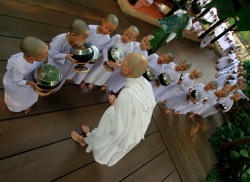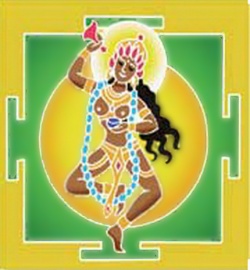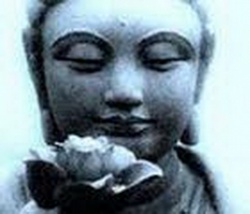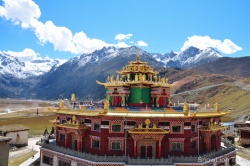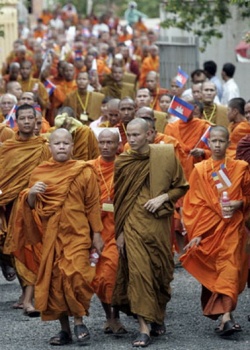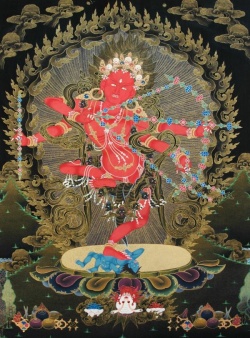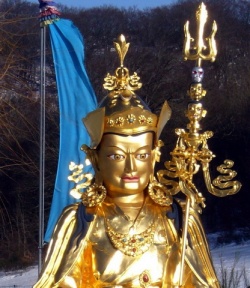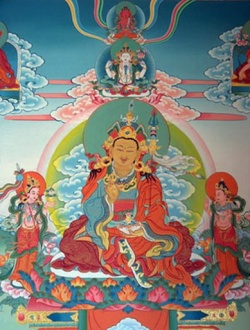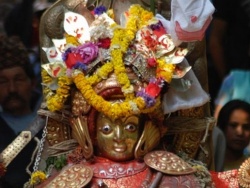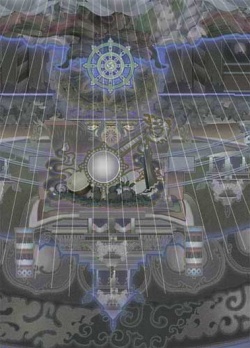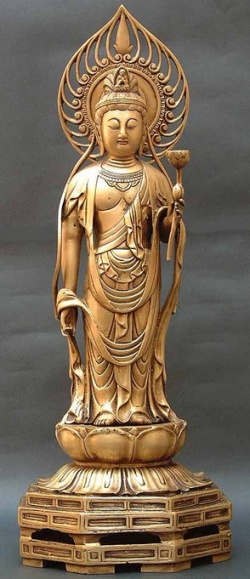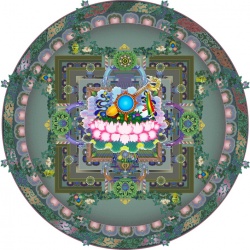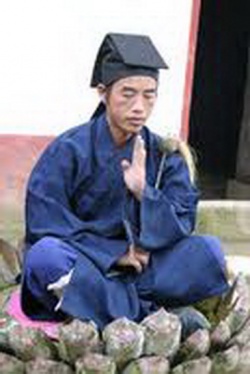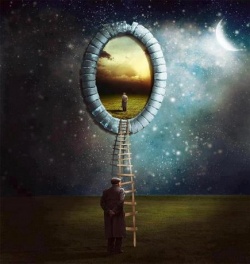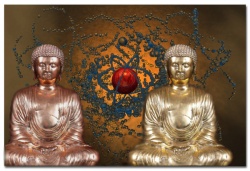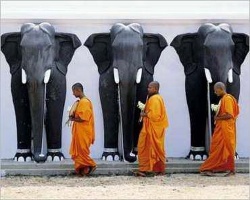Folk Religion in Tibetan Culture
This essay was written in 2000 by James Standen Taylor at the Tyndale University College and Seminary as part of the required course work towards a Master of Theology degree. The class was entitled, ‘Folk religion and Religious Encounter’, and was taught by Dr. Stanley R. Dyer.
The situation of folk religion in Tibetan culture is complicated due to it being a mixture from three sources: Mi-Chos (the native folk religion), Bon (an imported Shamanic movement) and the Tantric form of Buddhism that later came to dominance [Samuel, 1993, p.12]. From medieval times, this is so weaved together it is almost impossible to distinguish what belongs to where.
This has resulted in much argument over exactly how shamanic and folk corrupted are Tibetan Buddhist practices. However, outside those who have a bias for promoting Tibetan Buddhism as pure it is obvious to most authors that it is infiltrated on the ecclesiastical level by Shamanism, and on the popular level by folk religion
. Mi-Chos means “The Religion of Humans” [Stein, 1972, p.192]. [The following is based on Allen, 1999, pp.75-104; Stein, 1972, pp. 191-229; Samuel, 1993, pp.176-198]. It was part of Central Asian animism, centered on “spells, incantations, sacrifices, spirit possessions and magic drumming, and revolved around individuals who mediated between man and the forces of nature through their links with divine or demonic beings…(It) interprets the forces of nature as essentially hostile, but by seeking to live in harmony
with one’s biosphere life can be made easier. Everything in nature has spirit or energy, so it follows that the earth is sacred and there can be no divide between the spiritual and earthly,”[Allan, 1999, p.87, 89]. Tibetans call the life force bla, and it fills particular objects (people, mountains, lakes, trees et ceteras] being similar to mana, which then become gnas.
These are then considered rten, and the home of a deity, to which pilgrimage is made for empowerment. [Allan, 1999, p.91-92]. The bla-gnas structure becomes a hierarchy of spirits, from the [[sky [beings]], to the mountain top gods, the spirits of valleys and water, demons and elementals. The mountain gods are the most ferocious, due to the danger of crossing passes and the weather
coming from them [Allan, 1999, pp.93-94]. A person’s bla is not only in himself, but also in a number of external objects, similar to totems. Mi-Chos contains the repository of Tibetan myths, genealogies, and legends that are non-Buddhist. In its cosmology, it made the human body and household a microcosm of the universe. It also made the cyclical rhythm of non-Buddhist festivals. The idea that the
soul leaves at death through a hole in the roof of the home and travels a rainbow bridge to the afterlife originates here, as well. Van Beek sums up, “The Tibetans had followed a fundamental religion which attempted to reconcile the place of humankind in heaven and earth. It
soon developed into a form of animism which postulated the existence of spirits in trees, rocks and mountains. Elaborate propitiation rituals were developed to quell malevolent spirits and encourage benevolent spirits to served human needs,” [Van Beek, 1999, p. 11].
Tibetans turn to their folk religious heritage to deal with every day issues, in which they are more interested than they are in discovering the answers to ultimate questions. Due to its widespread nature, lamas have had to closely incorporate it into their duties. The major concern is the correct dealing with spirits to bring blessing and avoid calamity. “Folk
Tibetan Buddhists live in a world that teems with malignant, aggressive, and violent spirits who can cause great mischief if not properly handled…The ordinary Tibetan…lives in constant fear of these spirits and the evil they bring. No trouble is too great, no
journey too long, and no cost too high to avoid evil spirits, or to placate them once they have been offended. When a folk Tibetan Buddhist is troubled by sickness in the family or by business reversals, his first thought is to locate the source of the trouble in the spirit world around him, (using)…spiritual technologies…(such as) divination, sorcery, mediumship, and astrology,” [Tsering, 1988, p.105].
Functionaries include sorcerers, witches, mediums, oracles, diviners, and astrologers, dealing with divinations, curses, exorcisms, weather control, and spirit contact trances,” [Tsering, 1988, pp.106-107]. Buddhist lamas are often called on for the same things, and to produce magic charms. Two notorious accounts of this involve charms that were suppose to have made Tibetan
soldiers bullet proof against the Younghousband expedition in the early Twentieth Century, and the Chinese soldiers in the 1950’s. Both failed, throwing the Tibetans into doubt about the gods who were ‘protecting’ them [Maberly, unknown, p.135; Hopkirk, 1982, p.65, 74, 173].
The number of folk superstitions is endless. Fields are plowed in a zigzag pattern to trap the demons and expel them [Thomas, 1950, p.114]. Mining was prohibited to prevent the spirits of the ground from being upset [Thomas, 1950, p.167]. Even wheeled carts were a concern as they rutted and distorted the ground, angering the spirits [Thomas, 1950, p.186]. Spirit catchers are placed over the doors of houses to distract demons from entering and trap them [Feigan, 1996, p.66]. Pine cones from the sacred tree, believed to be as old as the
universe, in Kushuk Demdrug, protect you from animals, weapons and bad luck (Chan, 1994, p.759; Dowman, 1997, p.198]. Missionaries ran into many such things. They were thought to steal babies to make medicine, that their cameras were traps that stole souls, and Condy’s fluid [a medical aid] was the blood of those tricked into their company [Learner, 1933, p.23]. The tracts they distributed were thought to have magic power [Migot, 1955, p.164].
There was almost no Tibetan folk belief that was not absorbed into the new Buddhist worldview that came to prominence between the 600’s and 1500’s AD. The list of things that most Tibetan Buddhists think is Buddhist, but are really adaptations from Mi-Chos, is enormous. Some of the more prominent are:
- The ritual of kusang, which involved a burnt offering of incense, barley, and beer on high points Norbu, 1997, p.16].
- The luck ritual performed on rooftops on the morning of a wedding [Norbu, 19997, p.91].
- The wind horse used to take travelers on mystic journeys or to aid prayers on prayer flags [Bernbaum, 1980, p.165; Stein, 1972, p.273].
- The column placement in the Jokhang, Tibet’s most sacred Buddhist temple (Chan, 1994, p.66].
- The festivals and concerts held on the Jokhang’s roof to entertain the deities [David-Neal, 1986, p.269].
- Techniques for guiding the dead in the Tibetan Book of the Dead (Dowman, 1997, p.61; Stein, 1972, p.239]. ].
- The scapegoat festival in which a well paid man has the community’s sins, along with bad luck and evil spirits, magically transferred to him, which he carries off to the desert monastery of Samye, [David-Neal, 1986, pp.292-294].
- The interest in numerology (Dowman, 1997, p.60].
- The use of juniper in the New Year festival, and the festival welcoming back the cuckoo bird [Snellgrove, 1968, p266].
- The maypole rite [Allen, 1999, p.110].
- The fear of witches and witchcraft, which are blamed for many misfortunes [Samuel, 1993, p.189; Stein, 1972, p.199].
- The faith placed in astrology [David-Neal, 1965, p.50].
As Norbu points out, “most Tibetans believed more in the mysteries and superstitions of neo-Buddhism than in the rational teachings of the Buddha,” [1997, p.17].Isabel Robson agrees, “Buddhism was grafted on the old system of devil and nature worship. But as centuries have lapsed much of the higher teaching of Buddhism has been lost and lamaism today means, for the great majority of Tibetans, little more than a belief in the power of evil spirits and the constant necessity for propitiating them,” [Isabel Robson, unknown, p.35].
The religion of Bon came into Tibet and overlaid Mi-Chos, absorbing a lot of it and functioning as a second route through which it entered Tibetan Buddhism. It was founded by Tonpa Shenrab, a character from the legendary land of Olmolungring, which formed the model for the Tibetan belief in the mythic land of Shambhala Batchelor, 1998, p.231; Bernbaum, 1980, p.12-13, 80; Chan, 1994, p.751; Snellgrove, 1968, p.99], but was actually in Central Asia (Dowman, 1997, p.59; Stein, 1972, p.49]. He changed the Mi-Chos animal sacrifices into symbolic ones [Allen, 1999, p.226]. His story is buried in legend, and a copy of the Buddha’s life [Stein, 1972, p.242].
Bon spread to Tibet from its stronghold in the Shang Shung kingdom, which rose to power in Western Tibet, likely in the third to sixth centuries AD, around Mount Kailas, the physical representation of the world tree/cosmic spine in Hindu/Buddhist mythology [Mayhew, 1999, p.252; Allen, 1985, p.29; Chan, 1994, p.273, 784, 964, 972; Dowman, 1997, p.59; Stein, 1972, p.35; Snellgrove, 1968,
p.99; Allen, 1999, p.14, 126-127]. It filled Tibet with a shamanic oriented mindset [Samuel, 1993, pp.436-437]. Eventually, it had a political struggle with Buddhism, as Bon supported the old aristocratic traditions [Fiegan, 1996, p.50; Chan, 1994, p.296; Stein, 1972, p.68; Snellgrove, 1968, p.93]. The Bon king Lang Dharma persecuted Buddhism until his assassination by a Buddhist monk [Norbu, 1997, p.54, 370; Stein, 1972, p.69; Allen, 1999, pp.138-139].
Buddhism eventually triumphed, absorbing a great deal of Bon (see below), such that today the Bon and Nyingma Buddhist practices are very close in appearance [David-Neal, 1986, p.250; Dowman, 1997, p.59; Samuel, 1993, p.18]. It’s in the later you can most see the synthesis of Bon, folk religion, and Buddhism Snellgrove, 1968, p.106; Allen, 1999, pp.136-137]. Hardly surprising, the Nyingma were founded
by Padmasambhava, a Tantric sorcerer, and basically evolved into a Buddhist shamanism (Dowman, 1997, p.64-67]. European travelers have constantly confused Nyingma practitioners with those of Bon [Stein, 1972, p.240]. Originally, Bon was a cruel form of shamanism, now called Black Bon, dominated by animal sacrifice and the manipulation of the spirit world (Dowman, 1997, p.58, 126].
It became New Bon by assimilating aspects from the Buddhist schools (Dowman, 1997, p.58; Stein, 1972, p.241]. Black Bon sacrifice originally involved humans and animals, and bloody rituals contained gouged out eyes, drinking blood from skulls, torture, and body parts offered as war trophies,” [Fiegan, 1996, p.65]. Yet, despite the assimilation, they’re one of the few cases you can point to where Buddhists have physically persecuted another religion [Allen, 1999, p.15, 253].
The evaluation of ancient Bon as a shamanic religion is almost universal. They’re described in all surviving contemporary documents from surrounding cultures as shamans and sorcerers [Stein, 1972, p.235]. Learner, states, “Up to the seventh century the people of the land had a primitive religion consisting only of witchcraft and sorcery. Shamanism is the name that has been given
to it [1933, p.52]. Feigon, evaluates it: “Bon, the original Tibetan religion, was a shamanistic cult in which priests used magic rituals and hexes to control mountain, forest, and water demons. Followers worshiped the spirits of local mountaintops and lakes,” [1996, p.42].
Evans-Wentz states: “The teachings of Bon…were animistic, the spiritualised forces of man and nature being worshipped, chiefly in their awe-inspiring and terrifying aspects; and certain rituals were performed for the benefit and the guidance of the dead…Every tree and grove, and every locality, is held to have its own peculiar deities,” [[[Wikipedia:Evans-Wentz|Evans-Wentz]], 1980, p.lvii]. This historical evaluation
continues into modern understandings of contemporary Bon. Allen, an advocate of Bon, admits, “To this day unreconstructed Bonpo continue to follow the old ways of undeveloped, shamanistic Bon…As Nagpa or sorcerers, they counteract evil spirits, cure sicknesses and make weather…The second group of Black Bon shamans practice a more powerful and even sinister form of magic. They call themselves
Pawo… Bonpos, reformed or otherwise, still believe in harnessing the forces of nature to combat evil and in controlling the basic spirit powers as a means to enlightenment,” [Allen, 1999, pp.230-231, 259]. Fear and control of demons was the basis of Bon, giving the people “a healthy respect for the spirits of the land,” [Berry, 1989, p.30].
Like with Mi-Chos, there is a whole list of Shamanistic things that have been absorbed from Bon into Tibetan Buddhism, usually completely unknown to the average follower. Some prominent ones include:
- The terma tradition in which secret religious texts are discovered [Allen, 1999, p.138, 254, 258; Samuel, 1993, p.462].
- The Kalachakra Tantra, one of Tibet’s most famous “Buddhist” practices [Allen, 1999, pp.253-257, 273]
- Dzogchen, a Tibetan form of Zen; and the mythical country of Shambhala [Allen, p.272].
- The Dakinis, female spirits now seen as Buddhist deities [Allen, 1999, p.131].
- The ability of magic daggers to absorb strength through use and gain intrinsic power [David-Neal, 1965, p.104].
- The use of an effigy in the funeral rites; and animal headed deities in the Tibetan Book of the Dead [[[Wikipedia:Evans-Wentz|Evans-Wentz]], 1980, p.23, 37].
- The Nine Ways of Bon were largely taken over, for example: divination, astrology, propitiation of spirits and gods for safety and gaining luck, exorcism, death rituals, and the hidden text traditions (Dowman, 1997, pp.60-63; Allen, 1999, pp.230-231].
- The gods and demons of Nyingma Buddhism are almost all from Black Bon (Dowman, 1997, p.59].
- The Chod rite, a ritual in which the practitioner visualizes eviscerating himself and offering his organs to the deities, is shamanic in origin, as are many elements in the mystery plays, which originally involved human sacrifice to clear out the old year and the bad luck brought in it by demons.
[[[Wikipedia:Evans-Wentz|Evans-Wentz]], 1978, pp.284-285, 319; Allen, 1999, p.119; Samuel, 1993, p.477].
- The oracle system, and the deities invoked [[[Wikipedia:Evans-Wentz|Evans-Wentz]], 1980, p.lvi]
One finds Bon influence particularly on famous pilgrimage circuits. Between Menri and Sembon, for example, is a tree called
Thangshing Durtro, on which the corpses of babies are left in crates, with their possessions in plastic bags, in the belief that the tree contains
eternal life and can cleanse the dead children of sins from past lives (Chan, 1994, pp.753-754; Dowman, 1997, pp.199-200]. Hair is considered inviolate, and leaving some behind on the Sadhak Tshok pilgrimage route symbolizes casting off your sins and being
renewed. A little further on is a stone they believe they can sit on and have their sins leached out (Chan, 1994, p.755-756]. At another point, abandoned walking sticks leave sin behind [p.757] and notched sticks on the side of a cliff help spirits climb to the heavens (Dowman, 1997, p.200]. These have all been taken over from the previous use of these sites by Bon practitioners.
Most people who have studied a more pure form of Indian Buddhism are quite shocked when encountering Tibetan Buddhism, and can easily see the shamanic and folk elements that have grown on it. Many of these are visible in other Buddhist countries, but not to the central extent found in Tibet [Samuel, 1993, p.7]. For example, Tibetan Buddhist religious functionaries have been seriously co-opted into taking over many of the roles normally held by the shaman, such as being expected to act as exorcists [David-Neal, 1986, p.115].
Historically, Tibet has been full of shamans. Central Asian Buddhism has become so shamanistic, that the word for shaman is a synonym for Buddhist monk. It runs in family lines, and the person is usually called at puberty to perform functions universal to shamans the world over. “The shaman is not a priest, although plenty of priests and monks within
Tibetan religion are clearly shamans,” [Allan, 1999, pp. 99-102]. Samuel adds: “Pragmatic concerns are dealt with by folk-religion practitioners, using techniques of spirit-mediumship and other forms of divination along with various kinds of rituals. They are also a primary area of concern for the lamas,”[Samuel, 1993, p.270], which is accomplished through Tantric power. Given the historical context in which Buddhism entered Tibet, this is hardly surprising.
Early Buddhism had trouble gaining converts, as Tibetans didn’t think it could deal with the spirits. It eventually won support by converting the spirits to being protectors of Buddhist teachings, though they were originally the personifications of natural forces and objects, such as storms and mountains [Berry, 1989, p.38]. (Interestingly, the Bon had earlier also felt the need to convert local spirits
to be protectors (Dowman, 1997, p.197].) The Buddhist synthesis is considered to have been founded by Padmasambhava, a Tantric adept from india with a heavy background in magic [Berry, 1989, p.42-43; Evans-Wentz, 1980, p.lv; Snellgrove, 1968, p.93], as he could see it was impossible to separate the Tibetans from their folk supernaturalism [Migot, 1955, p.103].
Anderson comments on this time: “In Tibet, the religion that preceded Buddhism was Bon, a shamanic faith densely populated with spirits and local deities. Buddhism absorbed much of this: The story of Padmasambhava’s life says that he encountered and tamed the spirits of the Tibetan mountains and made them protectors of the monasteries; the wrathful demons became part of the
complex symbolism of the Vajrayana, to be understood as projections of the unconscious,” [1980, pp.13-14; also, Dowman, 1997, p.67]. Many spirit beings were transferred into Buddhism from Bon, [Anderson, 1980, p. 82]. Padmasambhava was also responsible for
defeating the Bon in debate and establishing Buddhism as the court religion [[[Wikipedia:Evans-Wentz|Evans-Wentz]], 1981, p.26, 188], yet was himself strongly responsible for the shamanic elements in Tibetan Buddhism [Samuel, 1993, p.168-169]. Padmasambhava came because his predecessor, Santarakshita, followed a path of reason.
“There was no magic about him, and in Tibet he never stood a chance,” [Berry, 1989, p.39]. Thus, “(The Buddhism that came to power) was influenced by the already existing religion in that it embodied spirit worship and sorcery…that is, Buddhism corrupted by shamanistic practices and beliefs.” [Learner, 1933, p.52]. It did this largely through absorbing Bon’s emphasis on magic and ritual
[Feigan, 1996, p.65]. Dowman agrees: “Buddhism gained sway by assimilation of the old shamanic practices and its later evolution, the successive establishment of new religious orders, was a reforming process in which the old shamanic ways were gradually purged…The distinctive characteristics of Tibetan Buddhism developed as a response to the indigenous shamanism [1997, p.57].
Snellgrove adds: “The battle for the hearts and minds of all Tibetans was a hard one for the Tibetan Buddhist clergy, and it was possible for them to replace the Bon-pos only by remaining to some extent Bonpo at heart and by acquiring greater proficiency in such non-Buddhist practices as the cult of the local gods, oracles and divination, than the Bon-pos themselves. One of the
results of this is the great number of indigenous Tibetan divinities who have made their way into the Tibetan Buddhist pantheon, and whose right to be there no self-respecting Tibetan, whatever his religious order, would question,” Snellgrove, 1968, p.173]. This, of course, bleeds out into the public’s perception of the religion: “The so-called Buddhist population is practically Shamanist and a large number of
mediums: Bonpos, Pawos, Bunting, and Yabas of both sexes, even in the smallest hamlets, transmit the messages of gods, demons and the dead….It sometimes happens that different gods or spirits take possession of the medium one after another. Once in a while, the latter, under the impulsion given to him by one of these beings, will suddenly attack one of the public and beat him mercilessly” [David-Neal, 1965, p.20, 38]
This whole process of absorption went on for centuries, and effected both sides, often repeating things that were thought to be settled. Centuries after Padmasambhava’s wars with Bon deities, for example, these magical battles were replayed between Bon functionaries and Milarepa, Tibet’s great poet sorcerer, in which the holy Bon mountain Kailas was converted to a Buddhist
power center [Allen, 1985, p.31; Dowman, 1997, p.162-164]. He seems to have defeated Bon practices and deities by absorbing them into Buddhism [Stein, 1972, p.238; Samuel, 1993, p.476]. Also, “(King) Trisong Detsen’s Buddhists embraced Bon rituals used to attain practical goals such as accumulating wealth or destroying enemies. Tibetan Buddhists engaged in activities abhorrent to members of their
faith in other countries,” [Feigen, 1996, p.49]. A later synthesis was undertaken by Atisa, who tried to harness the desire for shamanic power with a responsibly organized use of the same [Samuel, 1993, p.471-472]. Snellgrove sums up the end result of all this quite well:
“Internally, the Bon-pos tend to become the scapegoat for everything that had rendered the Buddhist conversion of Tibet at all difficult, while most Tibetan Buddhists themselves remain almost innocently unaware of the great variety of pre-Buddhist beliefs and practices that they have absorbed as an accepted part of their daily thoughts and actions,” Snellgrove, 1968, p.175].
After all this has been stated, however, one does find significant disagreement, and even denial, that Tibetan Buddhism is shamanic. Batchelor emphatically states: “A common misconception still prevails about Tibetan Buddhism that it is a Shamanistic
form of Buddhism heavily influenced by the indigenous Bon religion of Tibet,” [1998, p.29]. What has happened, according to Batchelor, is a mere appropriation of symbols being refilled with Buddhist meanings. Others agree and believe the majority of Buddhist mythology unique to
Tibet is borrowed from Bon, but in a way that doesn’t compromise the Buddhist message [Mayhew, 1999, p.13]. Batchelor tries to bolster his case with: “About 90% of the ‘demonic’ deities one sees are actually Indian in origin,” [1998, p.29], but the rest are Bon [[[Wikipedia:Evans-Wentz|Evans-Wentz]], 1981, p.60].
There are a number of reasons for this disagreement. Historically, Bon has been transformed into pseudo-Buddhism. This more recently developed similarity was then historically misconstrued, as today it’s difficult to distinguish Buddhist and Bon institutes on the surface, and Tibetan Buddhism is so adapted to Tibetan cultural forms it looks strangely not Buddhist. Yet, even Batchelor agrees
that “the primitive spirit of Bon is perhaps best preserved not in an official Bon establishment, but in some of the eerie protector chapels of even the most orthodox Buddhist monasteries” [1998, p.230]. David-Neal vividly describes one of these thus: “Here, as in some
other monasteries, grim wonders were said to happen. Sometimes blood sweated through the boards of the shrine where Mahakala was shut up, and at other times, on opening it, the remains of a human heart or brain were found. These signs…betoken the occult activity of the terrible deity,” [1965, p.47].
Batchelor seems to think all the influence was in the direction of Bon, but that isn’t true, as has been shown above. The problem here is really that a lot of this anti-Bon sentiment comes from the fact that Tibetan Buddhism is carefully presented to the West in a sanitized form,
so proponents of it present a less animistic version, more in tune with the tastes of Westerners [[[Lopez]], 1998, pp.198-201]. Another aspect of the problem appears to be on the level of folk religion, where the general populace freely mixes meanings. This is why some
authors claim no influence, while others do. Mayhew, for example, states, “In Tibet the establishment of Buddhism was marked by its interaction with the native religion Bon.
This shamanistic faith which encompassed gods and spirits, exorcism and the cult of dead kings among other things, almost certainly had a major influence on the direction Buddhism took in Tibet. Many popular Buddhist practices such as prayer flags, sky burial, the rubbing of holy rocks, the tying of bits of cloth to trees and the construction of spirit traps all have
their roots deep in Bon tradition. The traditional blessing of dipping a finger in water or milk and flicking it to the sky derives from Bon…”[1999, p.50]. So, if one is acquainted more with monastic Buddhism, than popular Buddhism, one would be led to believe it isn’t as shamanistic. However, even here one has to be careful where one looks to not see the shamanism, as Tantric Buddhism was already full of magic, demonic deities, and sacrifice when it came to Tibet [Stein, 1972, p.191].
Bon has covered over a lot of its historical appearance with a veneer of Buddhism, though often reversed or in some way changed: symbols are mirrored backwards, the entire artistic style and many beings of Tibetan Buddhism are adopted but renamed, mantras are slightly reworded, scriptures are re-titled and re-edited. “The impact of Buddhism upon Bonism was so overpowering that the latter could only survive by adopting
Buddhist methods and interpreting its doctrine in Buddhist terminology, so that Bonism, as it survives today, is hardly more than an off-shoot of Buddhism, or merely another sect of Lamaism,” (Govinda, 1966, pp223-224]. Given the mutual growing together of the two traditions, it is easy to see where proponents of either can play the game of “no, it was us who influenced you.”
Tantra is far too complex to explain here, but one should not doubt it’s widely recognized shamanic character of spiritism and magic. It is the dominant form of Buddhism that entered Tibet in the Seventh Century, and contains huge amounts of
sympathetic magic, and a view of the cosmos as a unity, able to be manipulated by secret words and gestures [Migot, 1955, p.102]. Tantra “encourages possession by…spirits as a means toward final enlightenment,” [Tsering, 1988, p.19]. It is essentially similar to the basic concepts and rituals of Shamanism all over central Asia [Samuel, 1993, p.268].
In the last part of this paper I would like to now examine the way Tibetans interact with the spirit realm. Here, more than anywhere else, one can see the animistic, folk, and shamanic nature of everyday Tibetan religion.
The old Bon deities were believed to inhabit the mountains. The largest local mountain was the home of the chief deity, while surrounding smaller peaks were his ministerial spirits (Trungpa, 1979, p.23]. The mountains were also the homes of ancient hero gods, connected to the earliest kings Snellgrove, 1968, p.58-59]. Valleys were ruled by gods of the soil, attendants to the [[mountain
gods]], who lived in unusual landform, and were offended by any disturbance of the land, even plowing or house building Snellgrove, 1968, p.59]. All of these were absorbed into Tibetan Buddhism. These new Protector gods “are the regional deities of Tibet, some of whom date
from pre-Buddhist times, said to have been defeated in magical battle by Indian masters such as Padmasambhava and then converted to Buddhism…There was strong identification with local mountains and valleys and their deities,” [[[Lopez]], 1998, pp.196-197; Avedon, 1984, p.202; Chan, 1994, p.297; David-Neal, 1986, p.260; Stein, 1972, p.66].
This process of conversion has left a great tension in the average Tibetan’s life, however:
“By premodern times, (the old gods) had become in theory totally subject to the Tantric ritual power of the lamas…Yet the worldly gods are certainly thought of as capable of bringing both disease and prosperity, and for lay people in particular they remained forces to be reckoned with into the modern period. They are still communicated with regularly through various forms of spirit
mediumship…The local gods, along with the malevolent spirits, and the whole complex of ideas about divination, spirit-mediums, and good and bad fortune, are an important part of the symbolic language through which the Tibetans deal with pragmatic, this-worldly concerns.
They provide a critical set of symbolic associations through which the Tibetan landscape is perceived…The attention that the local gods receive in domestic ritual, and the role they played in the causation of illness and misfortune, suggests the important function that
they continue to fulfill for ordinary lay Tibetans…(L)ay villagers negotiate from a position of relative weakness with the gods, through spirit-mediums and regular offerings, and at the same time seek the patronage of the Tantric lamas, who can negotiate from a far stronger position, to keep the gods in their place,” [Samuel, 1993, pp.190-191].
In watching daily religious life, one gets the feeling that these deities have not completely cooperated with their conversion to serving Buddhist interests. Fear of ghosts, spirits, demons and gods is rampant. Testimony to this is important, given the view held by most Westerners that Tibet was a land of people living in personal peace due to Buddhism. Migot says: “The life of e
very Tibetan is dominated by religious preoccupations. He is conscious of being surrounded by demons who can be appeased by certain rites and ceremonies. Only the lamas have the knowledge and the authority to perform these, and this gives them a status of supremacy,” [1955, p.104].
Tsering adds: “In Buddhist Central Asia…demons and spirits are powerful forces that are feared or worshiped by the great majority of local people,” [1988, p.19]. Snellgrove: “The early Tibetans conceived of men as being continually beset by a whole variety of spiteful demons,
who were presumed to be directly responsible for human ailments and misfortunes,” [1968, p.58]. The depth of interaction becomes a form of bondage, as the spirits “are all-pervasive and affect every aspect of his daily life. In his daily routine he has to take full account of a number of domestic gods whose powers are limited to their specific roles: some are protectors of the person, others are guardians of specific areas of the home…livestock, horses and the fields.
All require oblations, offerings of food…and the burning of incense. Interaction with these gods and spirits governs life…Benevolent or
malevolent, it is to everyone’s advantage to find ways to placate the gods, spirits, demons and ghosts and turn their powers to good use,” [Allen, 1999, pp.95-96; Samuel, 1993, p.188-189]. Demons are even responsible for butter not churning, and need to be exorcised from the butter churn Norbu, 1997, p.16]. The average Tibetan lived in dread of fearsome creatures that had to be placated by countless offerings and
rituals, lest the deities vengeance be unleashed against man and beast. A whole trade in magic charms, and occult devices and practices, was needed to keep these beings in their place [Hopkirk, 1982, p.226]. The local gods may not be reliable, but they couldn’t be ignored. Small cairns of stone were often built for them as homes, and then offerings are made at them, hoping they will stay home, [Samuel, 1993, p.179, 183].
A major concern was disease. As in most folk contexts, this was seen as the result of a personal agent, not viruses and bacteria. Tibetans “never believe that any illness or accident has a natural cause. These are considered as the work of evil spirits, which are hunting for the vital principles of the beings to enslave them or feed upon them,” [David-Neal, 1986, p.194].
Robson also testifies that “severe illness is usually attributed to evil spirits, and the friends of the patients resort at once to the lamas, who are engaged to exorcise or ward of the malevolent ones,” [Isabell Robson, unknown, p.118]. Tibetan health care “relies more on spells, incantations and the exorcism of evil spirits than on even such inadequate medicines are known to his lama physicians,” [Thomas, 1950, p.230].
The main way to deal with all of this is to propitiate the deities through worship and ritual. Worship offerings include symbolic blood sacrifices, using representations of an object, displaying food, liquids, flowers and incense, offering merit, and redeeming animals from labor or slaughter. There’s even one where a person’s sins are transferred to a dough effigy, which is thrown away [Tsering, 1988, pp.108-109]. This is called a torma, which is a human figurine, filled with reproductions of [[Wikipedia:internal
organs|internal
organs]] and red juice for blood. This is a reminder of human sacrifice [Berry, 1989, p.31]. Sometimes, a demon, or an enemy’s soul is trapped in it and it is stabbed and beheaded by ritual dancers wearing deity masks [Stein, 1972, p190]. Though human sacrifice has stopped, Tibet still retains reminders of this past, as Thomas points out: “We had come to a sinister place and stopped
to appease the demons. At that point were two chortens. The larger one, across the valley from us, contained a copper urn. Many years ago when the chorten was built and people still clung fearfully to the old Bon superstitions and rites, blood was poured into the urn. A boy and girl, each eight years old, were sacrificed and their bodies placed in it.” [1950. P.89].
In more popular daily worship, bells are used to gain the attention of the idols before offerings are made [Learner, 1933, p.94]. “Images of deities were above all objects of worship and propitiation to whom offerings were made and prayers were recited, and before whom prostrations were performed, thereby generating merit for the practitioner,” [[[Lopez]], 1998, p.150]. Tibetan images and
statues are not complete until their consecration ceremony, in which they are animated with life, by having the deity represented come and live in the image. “The consecrated image of the deity thus is not a symbol of the deity but, effectively, is the deity, and there are numerous stories in Tibet of images speaking to their devotees,” [[[Lopez]], 1998, p151-152].
Lopez, not a Christian, agrees that any Christian would call all of this idolatry, and be right to do so [ibid. pp.152-153]. Quite often, worship is very simple, as witnessed by Norbu: “Behind the temple was a small eminence on which a stone altar had been erected, and here the inhabitants of Tengster would burn incense in honor of our protective deity and to beg him to grant peace and
prosperity to our village,” [Norbu, 1960, p.49]. Mixed into this was also the ancestor worship common to such societies, as well as a unique form in which particular ancestors who held high religious positions continually came back to retake their roles, keeping the ancestor alive in the community. This is the incarnate lama system [[[Lopez]], 1998, p.184], of which the Dalai Lama is the most widely known. However, some have argued that this system is an echo of animistic spirit possession [Samuel, 1993, p.196].
The most unique place in Tibetan culture where this spirit worship receives a response from the other side is in the system of oracles. Oracles are consulted by the populace for anything and everything, by both laity and the government [Tsering, 1988, p.105; Thomas, 1950, p.234; Samuel, 1993, p.191, 291-294]. To this day, the Tibetan government in exile still makes important decisions by consulting a state oracle possessed by the tutelary deity of Nechung Monastery, Dorje Drakden, though other deities may be so consulted.
The current state oracle’s history is a classic example of the calling of a shaman, and the possessions are described with details that parallel what many Christians would consider experiences of the demonic, [Avedon, 1984, pp.191-217]. Tibetans see all things as interconnected, thus omens and divination are very important, particularly due to the infestation of active gods and demons. Many
coincidences and synchronicities are looked for to determine whether an event is auspicious, and thus in favor of the gods. Ceremonies and offerings are made to clarify cloudy situations: geomancy, astrology, mediums, vibrating rice on drums, and possession, [Samuel,
1993, pp.191-196]. In Tibetan accounts, these oracles are highly accurate, but others disagree: “Ever since he had accused the present Oracle of being unreliable, he had been out of favor with him. The Oracle had condemned other innocent men before; yet the people still blindly believed him,” [Maberly, unknown, p.19].
It should be obvious from the above that Tibetan Buddhism is heavily influenced by shamanism and folk religion through a number of sources. This is hardly a dead issue now that Communist China has taken over and made the country technically materialistic. Tibetan Buddhism is reviving there, as well as around the world, due to the Tibetan Diaspora. Even today, these
ancient shamanic practices rear their heads with public impact. Shugden, for example, is a Geluk Buddhist protector deity, the deified spirit of a famous monk, Tulku DrkpaGyaltsen. The Dalai Lama, however, has come to see him as an evil spirit, causing trouble in the Tibetan community and embarrassing Buddhism, due to his offering of fire from lamps of human fat and
hair wicks. The controversy over this shamanistic cult has torn apart the Tibetan refugee community, resulting in protests against the Dalai Lama, at least one murder, and riots. [[[Lopez]], 1998, pp.189-196].
Canadian email address for James S. Taylor.
Jim050@sympatico.ca
BIBLIOGRAPHY
ALLEN, Charles. 1985. A Mountain In Tibet. London: Futura Publications.
_____________. 1999. The Search For Shangri-La. Great Britain: Little, Brown & Company.
ANDERSON, Walt. 1980. Open Secrets: A Western Guide to Tibetan Buddhism. New York: Penguin Books.
AVEDON, John. 1984. In Exile From The Land Of Snows. New York: Alfred A. Knopf.
BATCHELOR, Stephen. 1998. The Tibet Guide: Central And Western Tibet. Boston: Wisdom Publications.
BERNBAUM, Edwin. 1980. The Way To Shambhala. New York: Anchor Books.
BERRY, Scott. 1989. A Stranger In Tibet. New York: Kodansha International.
CHAN, Victor. 1994. Tibet Handbook: A Pilgrimage Guide. California: Moon Publications.
DAVID-NEEL, Alexandra. 1983. My Journey To Lhasa. Boston: Beacon Press.
_____________________. 1984. Magic And Mystery In Tibet. Boston: Mandala Books.
DOWMAN, Keith. 1997. The Sacred Life Of Tibet. New York: Harper Collins.
EVANS-WENTZ, W. Y. 1978. Tibetan Yoga And Secret Doctrines. Oxford: Oxford University Press.
___________________. 1980. The Tibetan Book Of The Great Liberation. Oxford: Oxford University Press.
___________________. 1981. The Tibetan Book Of The Dead. Oxford: Oxford University Press.
FEIGON, Lee. 1996. Demystifying Tibet. Chicago: Elephant Paperbacks.
GOVINDA, Anagarika. 1966. The Way Of The White Clouds. Boulder: Shambhala.
HOPKIRK, Peter. 1983. Trespassers On The Roof Of The World. Oxford: Oxford University Press.
LEARNER, Frank. 1933. Rusty Hinges. Toronto: China Inland Mission.
LOPEZ, Donald. 1998. Prisoners Of Shangri-La. Chicago: University of Chicago Press.
MABERLY, Allan. ? God Spoke Tibetan. California: Harvest House Publishers.
MAYHEW, Bradley. 1999. Tibet. Oakland: Lonely Planet.
MIGOT, Andre. 1955. Tibetan Marches. London: Rupert Hart-Davis.
NORBU, Dawa. 1997. Tibet: The Road Ahead. Great Britain: Prospero Books.
ROBSON, Isabel. ? Two Lady Missionaries In Tibet. London: S. W. Partridge & Co.
SAMUEL, Geoffrey. 1993. Civilized Shamans: Buddhism In Tibetan Societies. Washington: Smithsonian Press.
SNELLGROVE, David & RICHARDSON. 1968. Hugh. A Cultural History Of Tibet. Boulder: Prajna Press.
STEIN, R. A. 1972. Tibetan Civilization. California: Stanford University Press.
THOMAS, Lowell. 1950. Out of This World. New York: The Greystone Press.
TRUNGPA, Chogyam. 1979. Born In Tibet. Boston: Unwin Paperbacks.
TSERING, Marku. 1988. Sharing Christ In The Tibetan Buddhist World. Scarborough: Interserve.
VAN BEEK, Steve. 1999. Tibet: Lhasa To Katmandu. New York: Langenscheidt Publishers Inc.
